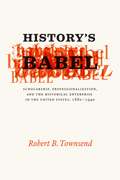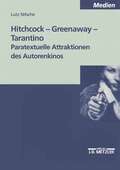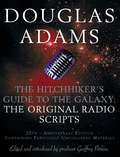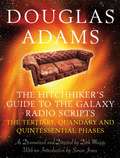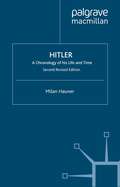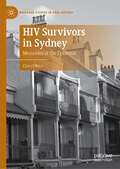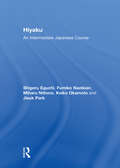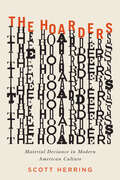- Table View
- List View
History's Babel: Scholarship, Professionalization, and the Historical Enterprise in the United States, 1880 - 1940
by Robert B. TownsendFrom the late nineteenth century until World War II, competing spheres of professional identity and practice redrew the field of history, establishing fundamental differences between the roles of university historians, archivists, staff at historical societies, history teachers, and others. In History’s Babel, Robert B. Townsend takes us from the beginning of this professional shift—when the work of history included not just original research, but also teaching and the gathering of historical materials—to a state of microprofessionalization that continues to define the field today. Drawing on extensive research among the records of the American Historical Association and a multitude of other sources, Townsend traces the slow fragmentation of the field from 1880 to the divisions of the 1940s manifest today in the diverse professions of academia, teaching, and public history. By revealing how the founders of the contemporary historical enterprise envisioned the future of the discipline, he offers insight into our own historical moment and the way the discipline has adapted and changed over time. Townsend’s work will be of interest not only to historians but to all who care about how the professions of history emerged, how they might go forward, and the public role they still can play.
History's Queer Stories: Retrieving and Navigating Homosexuality in British Fiction about the Second World War (Queer Studies #19)
by Natalie Marena NobitzCritical analysis of the dramatisation of homosexuality in British fiction about the Second World War is noticeable only by its relative absence from the field. Whereas feminist literary criticism has broadened the canon of war fiction to include narratives by and about women, queer scholars have seldom focused on literary representations of homosexuality during the war. Natalie Marena Nobitz closes a glaring gap in the critical attention of four novels dealing with the disruption of gender roles and institutionalised heteronormativity: Walter Baxter's Look Down in Mercy (1951), Mary Renault's The Charioteer (1953), Sarah Waters' The Night Watch (2006) and Adam Fitzroy's Make Do and Mend (2012).
Histrionic Hamlet: Shakespeare's Ultimate Metatheatrical Experiment (Routledge Studies in Shakespeare)
by Piotr SadowskiAccording to psychological research on acting, the histrionic personality consists of a compulsive tendency to play-act, exaggerate emotions, succumb to illusions, seek attention through speech, body language and costume, to be seductive and impulsive. An original intervention in the critical history of Shakespeare’s most famous play, Histrionic Hamlet argues that the Danish Prince is a stage representation of just such a personality—a born actor and a drama queen rather than a politician—incongruously thrown in the middle of ruthless high-stakes power struggle requiring pragmatic rather than theatrical skills. Uniquely among other English revenge tragedies, in Hamlet a histrionic protagonist striking a series of gratuitous, baffling, self-indulgent, and counterproductive poses is called upon to carry out a challenging and brutal political task, which he spectacularly and tragically mismanages. Unable to perform on a theatrical stage as a professional actor, the Clown Prince bitterly play acts anyway, turning all situations into opportunities of pretend play rather than effective political action. In consequence he wastes tactical advantages over his enemies, endangers himself, and jeopardizes his revenge plan, if ever there was one. Histrionic Hamlet should be of interest to students of Shakespeare, theater practitioners, and anyone interested in human dysfunctional and maladaptive behavior.
Histrionic Hamlet: Shakespeare's Ultimate Metatheatrical Experiment (Routledge Studies in Shakespeare)
by Piotr SadowskiAccording to psychological research on acting, the histrionic personality consists of a compulsive tendency to play-act, exaggerate emotions, succumb to illusions, seek attention through speech, body language and costume, to be seductive and impulsive. An original intervention in the critical history of Shakespeare’s most famous play, Histrionic Hamlet argues that the Danish Prince is a stage representation of just such a personality—a born actor and a drama queen rather than a politician—incongruously thrown in the middle of ruthless high-stakes power struggle requiring pragmatic rather than theatrical skills. Uniquely among other English revenge tragedies, in Hamlet a histrionic protagonist striking a series of gratuitous, baffling, self-indulgent, and counterproductive poses is called upon to carry out a challenging and brutal political task, which he spectacularly and tragically mismanages. Unable to perform on a theatrical stage as a professional actor, the Clown Prince bitterly play acts anyway, turning all situations into opportunities of pretend play rather than effective political action. In consequence he wastes tactical advantages over his enemies, endangers himself, and jeopardizes his revenge plan, if ever there was one. Histrionic Hamlet should be of interest to students of Shakespeare, theater practitioners, and anyone interested in human dysfunctional and maladaptive behavior.
A Hitch in Time: Writings from the London Review of Books
by Christopher Hitchens'Revisiting this selection of diaries and essay-reviews from the London Review of Books is restorative, an extended spa treatment that stretches tired brains and unkinks the usual habitual responses where Hitchens is concerned.' James Wolcott in his introduction Christopher Hitchens was a star writer wherever he wrote, and the same was true of the London Review of Books, to which he contributed sixty pieces over two decades. Anthologised here for the first time, this selection of his finest LRB reviews, diaries and essays (along with a smattering of ferocious letters) finds Hitchens at his very best. Familiar bêtes noires - Kennedy, Nixon, Kissinger, Clinton - rub shoulders with lesser-known preoccupations: P.G. Wodehouse, Princess Margaret and, magisterially, Isaiah Berlin. Here is Hitchens on the (first) Gulf War and the 'Salman Rushdie Acid Test', on being spanked by Mrs Thatcher in the House of Lords and taking his son to the Oscars, on America's homegrown Nazis and 'Acts of Violence in Grosvenor Square' in 1968. Edited by the London Review of Books, with an introduction by James Wolcott, this collection recaptures, ten years after his death, 'a Hitch in time': barnstorming, cauterising, and ultimately uncontainable.
Hitchcock - Greenaway - Tarantino: Paratextuelle Attraktionen des Autorenkinos
by Lutz NitscheDer wichtigste "special effect" des Autorenkinos ist das Image seiner Regisseure. Filme werden vom Publikum leidenschaftlicher gesehen, in der Öffentlichkeit intensiver kritisiert, wenn neben der Leinwand die Imagination einer Künstlerpersönlichkeit aufscheint. Die Studie beschreibt die Verflechtung von filmischem Oeuvre und jenen Randzonen, die Gérard Genette als Paratexte bezeichnet: Interview, Werbeanzeigen und die filmische Selbstdarstellung. Mit welcher Rhetorik evozieren diese Paratexte das Charisma des Star-Regisseurs? Welchen Anspruch auf Autorschaft formulieren sie? Am Beispiel von drei Regisseuren wird eine paratextuelle Pragmatik des Autorenkinos entwickelt. Der hier vorgestellte Blick fällt seitlich auf das Werk. Und es zeigt sich, dass dort Autoren zu entdecken sind - jenseits der Leinwand.
The Hitchhiker's Guide to the Galaxy: The Original Radio Scripts
by Douglas AdamsMarch 1978 saw the first ever transmission of Douglas Adams' The Hitchhiker's Guide to the Galaxy on BBC Radio 4; the beginning of a cult phenomenon. The Hitchhiker's Guide to the Galaxy: The Original Radio Scripts includes a previously unpublished Hitchhiker script, 'Sheila's Ear'; an introduction by producer Geoffrey Perkins; and a Who's Who of all those involved in the radio series. This scriptbook features all twelve original radio scripts - Hitchhiker as it was written and exactly as it was broadcast for the very first time. They include amendments and additions made during recordings and original notes on the writing and producing of the series by Douglas Adams and Geoffrey Perkins. For those who have always loved Douglas Adams, as well as for his new generation of fans, these scripts are essential reading - with the previously 'lost' script making this edition a must-have piece of Adams memorabilia.
The Hitchhiker's Guide to the Galaxy Radio Scripts Volume 2: The Tertiary, Quandary and Quintessential Phases
by Douglas AdamsTwenty-five years after the original radio series of The Hitchhiker's Guide to the Galaxy exploded into the public consciousness, the further exploits of its bewildered hero Arthur Dent were finally adapted for radio by Dirk Maggs, in part using drafts written by Douglas Adams before his death. The resulting fourteen completely new episodes were produced by Above the Title Productions and broadcast on BBC Radio 4, with nearly all of the original cast reunited for recording.The Hitchhiker's Guide to the Galaxy Radio Scripts Volume 2 brilliantly bring to life the last three books in Adams' perennially popular Hitchhiker series: Life, the Universe and Everything; So Long, and Thanks for All the Fish; and Mostly Harmless. Dirk Maggs supplies notes which highlight original Adams material and explain how the cast, special effects and music were directed. The scripts are introduced by Simon Jones, who played Arthur Dent in both the original and the recent radio series, as well as in The Hitchhiker's Guide to the Galaxy television series. Douglas Adams first conceived The Hitchhiker's Guide to the Galaxy for radio and it is an honour to his memory that all five Hitchhiker novels have now been adapted for this medium. These scripts exemplify the freshness of perspective, humour and perspicacity that epitomize the work of Douglas Adams.
The Hitchhiker's Guide to Writing Research: A Festschrift for Steve Graham (Literacy Studies #25)
by Xinghua Liu Michael Hebert Rui A. AlvesThis book brings together the work of established scholars from around the world to celebrate and honor the many ways in which Steve Graham has contributed to the advancement of teaching and researching writing. Focusing on writing development and writing instruction in different contexts of education, original contributions in this book critically engage with theoretical and empirical issues raised in Steve Graham’s influential body of work and significantly extend our understandings of the importance of writing in developing learners’ literacy and the roles of writing in teaching and learning processes.This book is organized around themes central to Steve Graham's work, including theories and models of writing, effective instructional methods in teaching writing, surveys on teaching and learning writing, and systematic review studies on writing. Apart from regular chapters, the book also features personal and scholarly reflections revealing the powerful ways in which Steve Graham’s work has influenced our thinking in the field of writing research and continues to open up new avenues for future research endeavors.
Hitler: A Chronology of his Life and Time
by M. HaunerThis detailed reference guide, based on a vast amount of source data, traces every known detail of Hitler's career, with extensive quotation both from Hitler's own speeches and writings and from those of his contemporaries. This new edition features an enlarged and updated bibliography and introduction.
Hitler's Followers: Studies in the Sociology of the Nazi Movement (Routledge Library Editions: Nazi Germany and the Holocaust)
by Detlef MuhlbergerWhen originally published in 1991, this book was the first systematic, detailed evaluation of the social structure of the Nazi Party in several regions of Germany during its so-called Kampfzeit phase. Based on extensive archival material, much of it left untouched since the end of the war until Detlef Mühlberger uncovered it, the book demonstrates that the Nazi Party and its major auxiliaries, the SA and the SS mobilized support which was remarkably heterogeneous in social terms. The author reveals that in addition to followers from the middle and upper social classes the Nazi Party enjoyed strong support among the lower class and it was indeed, as it claimed to be a people’s party, or Volkspartei.
Hitler's Followers: Studies in the Sociology of the Nazi Movement (Routledge Library Editions: Nazi Germany and the Holocaust)
by Detlef MuhlbergerWhen originally published in 1991, this book was the first systematic, detailed evaluation of the social structure of the Nazi Party in several regions of Germany during its so-called Kampfzeit phase. Based on extensive archival material, much of it left untouched since the end of the war until Detlef Mühlberger uncovered it, the book demonstrates that the Nazi Party and its major auxiliaries, the SA and the SS mobilized support which was remarkably heterogeneous in social terms. The author reveals that in addition to followers from the middle and upper social classes the Nazi Party enjoyed strong support among the lower class and it was indeed, as it claimed to be a people’s party, or Volkspartei.
Hitler’s French Literary Afterlives, 1945-2017
by Manuel BragançaThis book analyses the successive appearances of Adolf Hitler in French fiction between 1945 and 2017. It discusses why, unlike what has been observed in the US and in the UK, it has proven problematic for French novelists to write about Hitler in their numerous fictional explorations of the Second World War. It examines the literary and ethical challenges of including historical characters such as Hitler in fiction, and demonstrates how these challenges evolved over time as memories of the Second World War also evolved in France. jhopok
Hitlers Reden 1919–1945: Eine sprachwissenschaftliche Analyse
by Hiroyuki TakadaHitlers Reden spielten eine entscheidende Rolle im Prozess der nationalsozialistischen „Machtergreifung“ und der späteren Durchsetzung ihrer Politik. Das Buch untersucht die Gründe für die enorme Wirkung von Hitlers Auftritten, indem es die 1,7 Millionen Wörter, die die Reden umfassen, systematisch und in ihrer Entwicklung analysiert. Unter Einbeziehung der historischen und technikgeschichtlichen Hintergründe sowie detaillierten Beschreibungen von Hitlers Auftreten, seinen Gesten und rhetorischen Mitteln entsteht so eine Gesamtdarstellung von Hitlers Entwicklung als Redner – von den euphorisierenden Anfängen in den Bierkellern bis zu den kaum mehr beachteten Einlassungen am Ende des Krieges.
Hitomaro and the Birth of Japanese Lyricism
by Ian Hideo LevyProfessor Levy explores the ritual origins of Japanese verse, the impact of Chinese and Korean literary influence on the seventh-century Court, and the rhetorical deification of the imperial family as the condition under which Hitomaro would begin his career as a Court poet.Originally published in 1984.The Princeton Legacy Library uses the latest print-on-demand technology to again make available previously out-of-print books from the distinguished backlist of Princeton University Press. These editions preserve the original texts of these important books while presenting them in durable paperback and hardcover editions. The goal of the Princeton Legacy Library is to vastly increase access to the rich scholarly heritage found in the thousands of books published by Princeton University Press since its founding in 1905.
The Hitopadesa
by M NarayanaComposed between 800 and 950 AD, Narayana's Hitopadesa is one of the best-known of all works in Sanskrit literature. A fascinating collection of fables, maxims and sayings in verse, it combines a wide variety of writings from earlier authors in one volume - a 'garden of pleasing stories' created to provide guidance, wisdom and political advice to the reader. With elegance and great humour, Narayana weaves a framework for the classic tales, here narrated by animals who quote from and reflect on stories from the Pancatantra and other traditional sources. At once an anthology of folk wisdom and an original and satirical work in its own right, the Hitopadesa has been deeply admired and widely read for more than a thousand years for its humorous and profound reflections on human lives, loves, follies and philosophies.
HIV/AIDS in Memory, Culture and Society (Palgrave Studies in Science and Popular Culture)
by Alicia Castillo Villanueva Angelos BollasThis volume examines the role of culture in developing social, cultural and political discourses of HIV/AIDS from a contemporary viewpoint. In doing so, the memory of HIV/AIDS is a powerful tool to examine representations of the past and connect them with future debates. This reassessment of HIV/AIDS explores the most appropriate way to come to terms with a past that involved a negative, stigmatised and marginalised representation. Therefore, remembering plays a key role in generating collective memory, which allows for the exchange of mnemonic content between individual minds, creates discourses on memory and commemoration, and disseminates versions of the past that may affect the representation of HIV/AIDS in the future. Indeed, rewriting about the past also means assessing our responsibility towards the present and the potential of transmission to future generations, especially in times of pandemics.
HIV Stories: The Archaeology of AIDS Writing in France, 1985-1988
by Jean Pierre BouléThis book draws attention to the existence in France of an AIDS literature from 1985 to 1988 before AIDS writing became either a widely recognised genre or a culturally influential form of writing. It is a predominantly literary critical study, informed by gender studies and psychoanalytic criticism in its readings of individual texts, and interwoven with contextual information.
HIV, Substance Abuse, and Communication Disorders in Children
by R. Dennis Shelby Robert M. ScreenMake sure every child gets a chance to be heardHIV, Substance Abuse and Communication Disorders in Children examines the language problems of young children from special populations. Essential as a textbook for graduate and upper-level undergraduate studies and as a reference resource, this unique book presents up-to-date research and compelling case studies that illustrate how prenatal exposure to drugs, alcohol, and HIV can affect a child in utero and continue to handicap its development after birth. Each chapter includes discussion threads and review questions to promote critical thinking and clinical problem-solving skills in the classroom.HIV, Substance Abuse and Communication Disorders in Children looks at the negative impact a mother&’s lifestyle practices can have on her developing child with a nod toward the significant prevalence of HIV and substance abuse in today&’s society. Some estimates place the number of infants born after prenatal exposure to illicit drugs as three-quarters of a million-every year. When alcohol is added, the figure rises to more than 1 million. This powerful book focuses specifically on the serious consequences of alcohol, marijuana, cocaine, and crack cocaine abuse, including poor language development and speech delays, limited vocabulary, the inability to make their needs known, poor articulation, the inability to follow commands, limited expressive language skills, and the inability to understand the real meaning of words and generalize them. And of the nearly 5,000 children in the United States living with AIDS, almost all will struggle with speech production and communication disorders as the disease affects their brain, spinal cord, and central nervous system. HIV, Substance Abuse and Communication Disorders in Children examines: the effect of drugs on the brain pregnancy and drug use trends common drugs of abuse Kosakoff&’s syndrome fetal alcohol syndrome (FAS) among Native Americans and African Americans neurologic sequellae speech and language intervention rehabilitation considerations treatment and family counseling and much moreHIV, Substance Abuse and Communication Disorders in Children is essential for graduate and undergraduate students working with language disorders in special populations.
HIV, Substance Abuse, and Communication Disorders in Children
by R. Dennis Shelby Robert M. ScreenMake sure every child gets a chance to be heardHIV, Substance Abuse and Communication Disorders in Children examines the language problems of young children from special populations. Essential as a textbook for graduate and upper-level undergraduate studies and as a reference resource, this unique book presents up-to-date research and compelling case studies that illustrate how prenatal exposure to drugs, alcohol, and HIV can affect a child in utero and continue to handicap its development after birth. Each chapter includes discussion threads and review questions to promote critical thinking and clinical problem-solving skills in the classroom.HIV, Substance Abuse and Communication Disorders in Children looks at the negative impact a mother&’s lifestyle practices can have on her developing child with a nod toward the significant prevalence of HIV and substance abuse in today&’s society. Some estimates place the number of infants born after prenatal exposure to illicit drugs as three-quarters of a million-every year. When alcohol is added, the figure rises to more than 1 million. This powerful book focuses specifically on the serious consequences of alcohol, marijuana, cocaine, and crack cocaine abuse, including poor language development and speech delays, limited vocabulary, the inability to make their needs known, poor articulation, the inability to follow commands, limited expressive language skills, and the inability to understand the real meaning of words and generalize them. And of the nearly 5,000 children in the United States living with AIDS, almost all will struggle with speech production and communication disorders as the disease affects their brain, spinal cord, and central nervous system. HIV, Substance Abuse and Communication Disorders in Children examines: the effect of drugs on the brain pregnancy and drug use trends common drugs of abuse Kosakoff&’s syndrome fetal alcohol syndrome (FAS) among Native Americans and African Americans neurologic sequellae speech and language intervention rehabilitation considerations treatment and family counseling and much moreHIV, Substance Abuse and Communication Disorders in Children is essential for graduate and undergraduate students working with language disorders in special populations.
HIV Survivors in Sydney: Memories of the Epidemic (Palgrave Studies in Oral History)
by Cheryl WareInner-city Sydney was the epicenter of gay life in the Southern hemisphere in the 1970s and early 1980s. Gay men moved from across Australasia to find liberation in the city’s vibrant community networks; and when HIV and AIDS devastated those networks, they grieved, suffered, and survived in ways that have often been left out of the historical record. This book excavates the intimate lives and memories of HIV-positive gay men in Sydney, focusing on the critical years between 1982 and 1996, when HIV went from being a terrifying unidentified disease to a chronic condition that could be managed with antiretroviral medication. Using oral histories and archival research, Cheryl Ware offers a sensitive, moving exploration of how HIV-positive gay men navigated issues around disclosure, health, sex, grief, death, and survival. HIV Survivors in Sydney reveals how gay men dealt with the virus both within and outside of support networks, and how they remember these experiences nearly three decades later.
Hiyaku: An Intermediate Japanese Course
by Shigeru Eguchi Fumiko Nazikian Miharu Nittono Keiko Okamoto Jisuk ParkHiyaku: An Intermediate Japanese Course provides a progressive intermediate course in Japanese, incorporating modern teaching methods and practicing all four language skills. Hiyaku provides content-based instruction, with authentic and semi-authentic dialogues and readings, all carefully selected to instruct and inspire students as they learn Japanese. Key features of the textbook include: highly structured chapters, beginning with warm-up exercises followed by focused practice of each of the four skills gradual introduction to increasingly authentic materials content taken from original Japanese sources such as books, TV programs, magazines, newspapers and websites extensive audio material provided as FREE MP3 files on a companion website instructor’s materials, including PowerPoint files provided through the companion website. Hiyaku does not simply teach language and basic cultural points: it also helps students gain a holistic understanding of Japanese society and history, and provides the necessary foundation for the advanced study of Japan and its language.
Hiyaku: An Intermediate Japanese Course
by Shigeru Eguchi Fumiko Nazikian Miharu Nittono Keiko Okamoto Jisuk ParkHiyaku: An Intermediate Japanese Course provides a progressive intermediate course in Japanese, incorporating modern teaching methods and practicing all four language skills. Hiyaku provides content-based instruction, with authentic and semi-authentic dialogues and readings, all carefully selected to instruct and inspire students as they learn Japanese. Key features of the textbook include: highly structured chapters, beginning with warm-up exercises followed by focused practice of each of the four skills gradual introduction to increasingly authentic materials content taken from original Japanese sources such as books, TV programs, magazines, newspapers and websites extensive audio material provided as FREE MP3 files on a companion website instructor’s materials, including PowerPoint files provided through the companion website. Hiyaku does not simply teach language and basic cultural points: it also helps students gain a holistic understanding of Japanese society and history, and provides the necessary foundation for the advanced study of Japan and its language.
The Hoarders: Material Deviance in Modern American Culture
by Scott HerringThe verb “declutter” has not yet made it into the Oxford English Dictionary, but its ever-increasing usage suggests that it’s only a matter of time. Articles containing tips and tricks on how to get organized cover magazine pages and pop up in TV programs and commercials, while clutter professionals and specialists referred to as “clutterologists” are just a phone call away. Everywhere the sentiment is the same: clutter is bad. In The Hoarders, Scott Herring provides an in-depth examination of how modern hoarders came into being, from their onset in the late 1930s to the present day. He finds that both the idea of organization and the role of the clutterologist are deeply ingrained in our culture, and that there is a fine line between clutter and deviance in America. Herring introduces us to Jill, whose countertops are piled high with decaying food and whose cabinets are overrun with purchases, while the fly strips hanging from her ceiling are arguably more fly than strip. When Jill spots a decomposing pumpkin about to be jettisoned, she stops, seeing in the rotting, squalid vegetable a special treasure. “I’ve never seen one quite like this before,” she says, and looks to see if any seeds remain. It is from moments like these that Herring builds his questions: What counts as an acceptable material life—and who decides? Is hoarding some sort of inherent deviation of the mind, or a recent historical phenomenon grounded in changing material cultures? Herring opts for the latter, explaining that hoarders attract attention not because they are mentally ill but because they challenge normal modes of material relations. Piled high with detailed and, at times, disturbing descriptions of uncleanliness, The Hoarders delivers a sweeping and fascinating history of hoarding that will cause us all to reconsider how we view these accumulators of clutter.
The Hoarders: Material Deviance in Modern American Culture
by Scott HerringThe verb “declutter” has not yet made it into the Oxford English Dictionary, but its ever-increasing usage suggests that it’s only a matter of time. Articles containing tips and tricks on how to get organized cover magazine pages and pop up in TV programs and commercials, while clutter professionals and specialists referred to as “clutterologists” are just a phone call away. Everywhere the sentiment is the same: clutter is bad. In The Hoarders, Scott Herring provides an in-depth examination of how modern hoarders came into being, from their onset in the late 1930s to the present day. He finds that both the idea of organization and the role of the clutterologist are deeply ingrained in our culture, and that there is a fine line between clutter and deviance in America. Herring introduces us to Jill, whose countertops are piled high with decaying food and whose cabinets are overrun with purchases, while the fly strips hanging from her ceiling are arguably more fly than strip. When Jill spots a decomposing pumpkin about to be jettisoned, she stops, seeing in the rotting, squalid vegetable a special treasure. “I’ve never seen one quite like this before,” she says, and looks to see if any seeds remain. It is from moments like these that Herring builds his questions: What counts as an acceptable material life—and who decides? Is hoarding some sort of inherent deviation of the mind, or a recent historical phenomenon grounded in changing material cultures? Herring opts for the latter, explaining that hoarders attract attention not because they are mentally ill but because they challenge normal modes of material relations. Piled high with detailed and, at times, disturbing descriptions of uncleanliness, The Hoarders delivers a sweeping and fascinating history of hoarding that will cause us all to reconsider how we view these accumulators of clutter.
